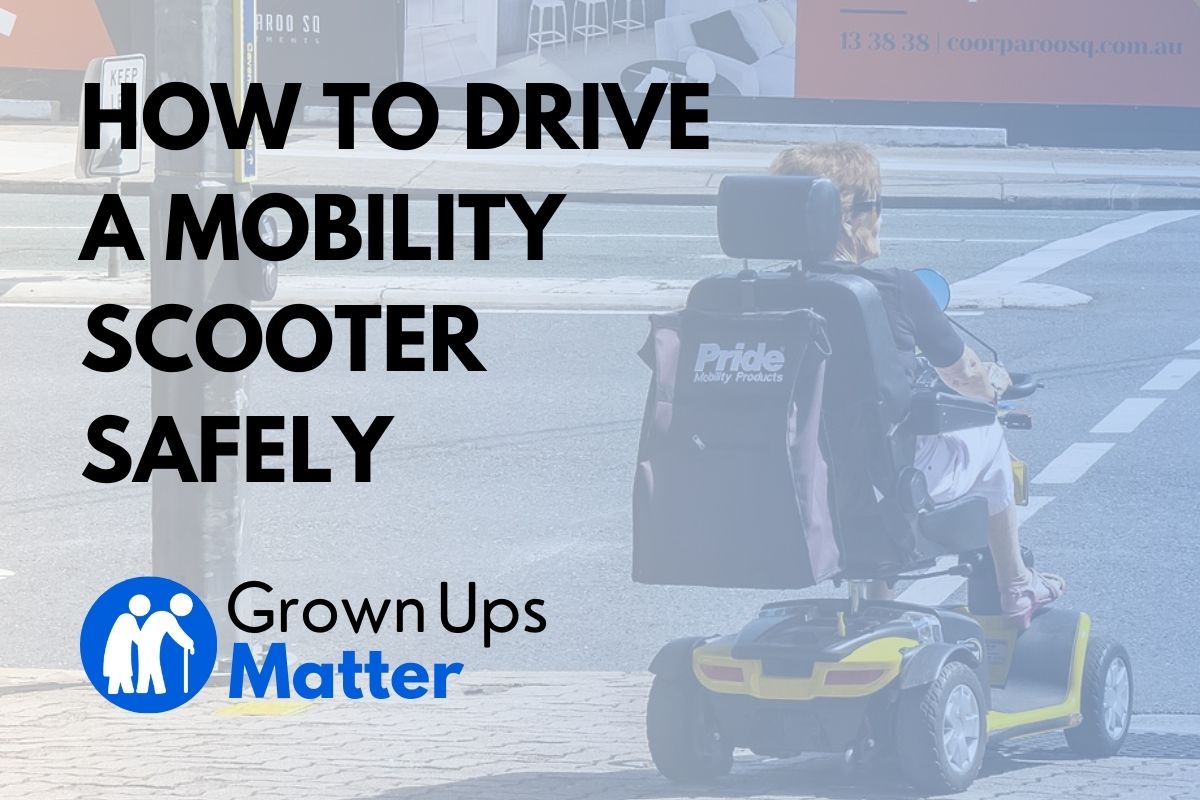As we age, mobility can become a challenge, making it harder to get around and enjoy life to the fullest.
That’s where mobility scooters come in – they offer a safe and convenient way to move around independently, whether you’re running errands or simply enjoying a leisurely ride in the park.
However, if you’ve never driven a mobility scooter before, it can feel overwhelming and even intimidating.
That’s why we’ve put together this article – to give you 17 tips on how to get started driving a mobility scooter.
In this post, we’ll break down the basics of mobility scooter operation, from understanding the controls to safety tips to keep in mind while you’re on the move.
We’ll also provide actionable advice on how to choose the right mobility scooter for your needs and preferences, so you can feel confident and comfortable on your new ride.
So whether you’re a first-time mobility scooter driver or looking to refresh your knowledge, keep reading for everything you need to know to hit the road with confidence.
Key Takeaways:
- Mobility scooters are designed to be easy to operate and maneuver and can be driven by almost anyone who meets certain basic physical requirements.
- When starting, it is important to choose the right scooter that is best for you and practice at home before driving in public.
- Always wear protective gear such as a bike helmet, and make sure your scooter has high visibility for night-time driving.
- It is important to be predictable and avoid driving too close to people, and always use your scooter on pedestrian paths while respecting pedestrian red lights.
- Don’t rush, control your speed, and inform your loved ones of your daily routine to ensure they know where to find you in case of an emergency.
Can Anyone Drive a Mobility Scooter?
In general, mobility scooters are designed to be easy to operate and maneuver and can be driven by almost anyone who meets certain basic physical requirements.
However, there are some limitations and qualifications to keep in mind.
First and foremost, it is important to have sufficient finger dexterity in at least one hand in order to operate the controls of the mobility scooter.
These controls typically include a tiller, which is a handlebar-like device that is used to steer the scooter, as well as various buttons and switches for controlling the speed and direction of the vehicle.
Some models may also have additional features, such as a horn, or lights, that require manual operation.
In addition to having adequate hand function, it is also important to be able to sit comfortably for long periods of time, this means that individuals who experience significant pain or discomfort while sitting may not be suitable candidates for using a mobility scooter.
Other factors to consider when determining whether someone can drive a mobility scooter include their overall physical and cognitive abilities, as well as their familiarity with operating motorized vehicles.
While mobility scooters are generally considered to be safe and easy to use, it is still important to exercise caution and follow basic safety guidelines when operating one.
17 Tips to Drive a Mobility Scooter Safely and Effectively
If you are just getting started with a personal scooter, there are certain things you should do and consider to ensure you will have a safe and effective increase in your quality of life by gaining extra independence provided by the device.
Here are 17 of the most important tips scooter drivers should consider:
1. Make Sure Your Scooter is Right For You
To begin with, choosing the scooter that’s best for you is the most important thing of it all.
There are many different types and models of scooters to pick from, and although the decision process might get a bit overwhelming at first, understanding their pros and cons will make it easier.
2. Use a Proper Driving Position
Scooters are designed to be very comfortable for the driver, and one can sometimes forget it is operating a vehicle that can go very fast in pedestrian spaces.
To ensure appropriate responsiveness and control over the device, it’s very important to adopt an upright driving position where you can reach all inputs and steer without limitations.
3. Practice With Your Scooter at Home
If you are unsure about certain maneuvers, have trouble switching driving modes, or are just insecure about driving in public, practicing at home is the best you can do.
Nobody was born knowing how to drive a scooter, and there’s no shame in taking a bit of time to train.
Be it at home, in your backyard, or neighborhood, with a few minutes of training you will surely be familiarized with the controls and how the vehicle reacts to your inputs.
4. Be Predictable
One of the most important things when operating such a device in public is being predictable.
I’m not saying you should announce your every move to everyone around you, but try to maintain straight lines, and don’t turn too abruptly or sharply.
5. Make Sure You Are Visible
Especially when driving at night, if your scooter has lights on it, make sure you turn them on.
You can also consider getting a high-visibility vest or adding reflective stickers to your scooter to ensure you will be seen.
6. Avoid Driving Too Close to People
The best thing you can do to prevent accidents with pedestrians is to avoid them.
Groups of people can be really unaware of their surroundings while walking and might unknowingly move into your path without even noticing.
Always try to surpass them, and remember it’s ok to use your horn to make them aware of your presence.
7. Always Use Your Scooter On Pedestrian Paths
Scooters are designed and intended to be used anywhere pedestrians are allowed, so be mindful about your routes.
Remember to always use crosswalks and respect pedestrian red lights.
8. Wear Protective Gear
It’s not a bad idea to wear a bike helmet when you drive your scooter, especially if you know there will be rough terrain ahead.
Although rare, accidents do happen, and it’s always better to be prepared.
9. Inform Your Loved Ones of Your Daily Routine
If you use your scooter daily to go to the shop or get to your activities, it’s a great idea to let people close to you know where you will usually be driving.
Especially if it’s a one-off trip, just call or text your family or friends and let them know where you are going.
Again, accidents are uncommon, but if something happens to you or your scooter, people will know where to look for you and send help.
10. Don’t Rush, Control Your Speed
Mobility scooters can go really fast when compared to the average person’s walking speed.
Combine this with pedestrians not being aware that you are behind them, and that’s the recipe for an accident.
Take your time, and control your speed, especially in crowded places or when you know kids might be around.
11. Avoid Sharp Turns
Powered scooters can tip over if you turn too abruptly at certain speeds.
Even when driving relatively slowly, it is an issue you should consider.
The best practice is to slow down almost to a stop before making hard turns.
Although 4-wheel scooters are known to be more stable, you shouldn’t be over-confident about that.
12. Mind the Terrain
As I mentioned before, most scooters are designed to be used on sidewalks mostly, so their performance on rough terrain, or even gravel is not great.
Be aware of where you are driving, and take it slow to ensure proper traction.
Also, uneven terrain will drain the batteries faster.
13. Plan Your Trips and Routes in Advance
Be conscious of where you are going and how you are getting there.
Have at least a rough idea of each path you will take to your destination, and consider if it has patches of rough terrain or if there are hills you will need to climb.
Remember inclination will also drain the battery of your scooter faster.
Take everything into consideration, especially for longer trips, to manage your vehicle’s range accordingly.
14. Take Care of Your Scooter
It’s fundamental that you take proper care of your scooter to maintain it in a safe working condition.
A personal mobility aid should be a reliable tool to assist you with your daily tasks and not something you should be worrying about not functioning properly.
We have developed a rigorous maintenance routine that you can bookmark and follow to take the guesswork out of your side.
15. Never Drink and Drive
As with any other vehicle or machinery, you should never drive under the influence.
We have a specific article about that, and the consequences you could be facing:
16. Be Extra Careful When Getting On and Off
An important part of using a scooter, particularly for people with severe mobility issues are getting on and off of it.
Be careful when leaning over the device, since too much unbalanced weight on one side can make it tip over, or even make the part you are holding come loose.
17. Don’t Worry About What Other People Think
Finally, a scooter is about freedom and independence, and although they are completely normal in our modern society, you will get an odd look now and then.
Don’t worry about other people, and just focus on your life and happiness.
Do You Need a License to Drive an Assistive Scooter?
You don’t need any kind of driver’s license or prescription to use your mobility aid in public.
Mobility scooters are not considered recreational vehicles and are intended to be used on sidewalks or pedestrian paths.
For specific information about this, check the following post:
Can You Take Your Scooter on the Road?
Personal scooters are not road-safe, nor street-legal.
You should never drive your scooter on the road since it’s not a safe environment for it, and you could cause an accident.
Remember powered scooters are pedestrian vehicles and they should be used anywhere you would otherwise go on foot.
We have a complete article on this topic:
Can You Use the Scooter on Bike Lanes?
Mobility scooters are usually not allowed on lanes or paths designated for cyclists.
However, regulations vary depending on the state.
For more info about it, I will refer you to the following article:
How to Take Proper Care of Your Scooter
Finally, the most important thing you can do to ensure driving your scooter is a safe and happy experience is to do periodic maintenance to it.
We have developed a routine you can follow that will cover the most important things you should look for, and we also give you tips about what are your best options for performing the light work required.
You can check that out here:
All the claims made in this article are only for informational purposes, based on the writer’s experience and not clinical advice. You should always consult your physician or physical therapist if you have any doubts about how this applies to your specific case.

Rami is an economist with a passion for personal finance and a desire to help people make the most of their retirement years. He’s also the tech mind that made all of this possible, and a marketing enthusiast. In his articles, Ramiro offers real-life advice and resources for seniors looking to manage their finances and make the most of their retirement savings. He is dedicated to helping his readers live comfortably and securely during their golden years.

